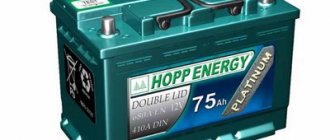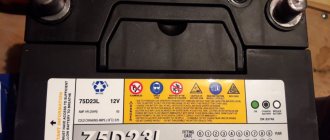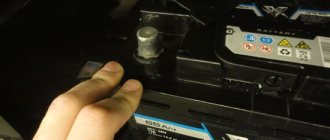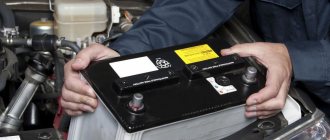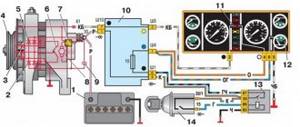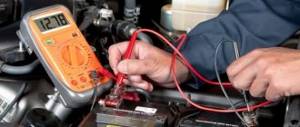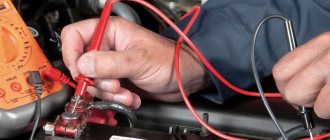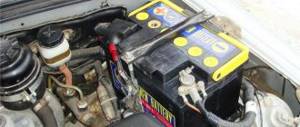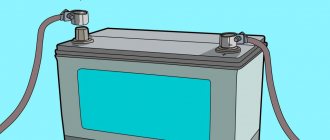Car battery life
Initially, before providing the product to the consumer, the product must be tested in laboratory conditions. Based on the results of experience, the manufacturer can judge the service life of the car battery. Depending on the type of power source, there are different stated expiration dates.
Antimony batteries
This type of power source is one of the most imperfect in its properties. It is still put up for sale due to its low cost, as well as the ability, if the operating rules are followed, to significantly extend its performance. According to GOST, the service life of a car battery with antimony in the plates is specified as up to 3 years. Warranty period up to 1 year.
Hybrid batteries
The main difference between this type of battery is the presence of alloying materials in the negative electrodes. Has a normal service life of up to 5 years. They do not require constant maintenance and have an increased cost.
Calcium nutrition sources
Maintained batteries have lead electrodes doped with a metal such as calcium. As a result of improving the composition of the plates, the shelf life is indicated to be up to 5 years; if the requirements for proper operation are met, it can be increased to 8 years.
Maintenance-free models have a special design feature - the absence of evaporation of the electrolyte when the charge is restored. These types of power supplies do not have the ability to control basic parameters, but they are common and considered the most practical.
Attention! As a result of proper storage and maintenance, the service life of a maintenance-free car battery is up to 7 years.
Traction batteries
This type is produced using various technologies and manufacturing features, but the various models have one condition in common: they retain their properties even when the battery is deeply discharged; some models can withstand up to 400 full battery discharges. Declared period from the manufacturer, preservation of performance up to 10 years.
AGM batteries
The design of these batteries uses special glass fiber impregnated with electrolyte, thanks to which they easily retain their useful properties during deep discharges for up to 10 years. They are maintenance-free.
EFB batteries
They are also resistant to full discharges. The latest developments and technologies are used in production. The service life of car batteries is 7 years from the date of issue.
Gel batteries
These power supplies use a thick substance instead of a liquid acid electrolyte, which reduces the likelihood of plates shedding and premature battery failure. The shelf life declared by the manufacturer is not less than 10 years, they are maintenance-free, and can withstand up to 400 full discharges.
Advice! Various technologies and materials are used in the manufacture of the power supply; to avoid premature failure of the battery, you must carefully study the instructions.
Real battery operating time
According to GOST, the service life of an antimony car battery is 2 years (with a mileage of no more than 90,000 km), a maintenance-free battery is 4 years (with a mileage of no more than 100,000 km).
The actual service life of a car battery depends on a number of factors:
- seasonality of operation;
- what mileage has been made by the car;
- the presence of built-in electronics, the correctness of its connection;
- stable functioning of automotive voltage regulators and generators;
- priority operating temperature mode;
- quality of battery service.
By taking these factors into account, you can properly extend the battery life.
The batteries of vehicles with intensive use (taxi, special vehicles, company cars, etc.) are susceptible to faster failure. The electrodes in them wear out in proportion to the vehicle's mileage, and additional electronics add load.
The lifespan of batteries on such cars does not exceed 1.5 years instead of the 4 years indicated by the manufacturer. With proper care of the battery of a personal car, replacement is carried out no more than once every 4 years, and with normal driving - much less often. The prolongation of the operation of the unit is facilitated by its quality, in particular, products from well-known brands, correctly selected for a specific make and model of car, last longer.
The main reasons for the reduction in battery life
Among the various reasons that affect battery life, there are several main ones:
- full and deep discharges;
- increased charge;
- constant shaking and vibrations;
- using a battery with insufficient charge;
- storage in a fully discharged state;
- external influences of temperatures and aggressive environments.
Using a power source with low electrolyte density in winter can lead to freezing of the liquid and failure of the battery. A faulty generator, as well as consumers switched on while the engine is not running, can lead to a complete discharge of the battery.
An increased charge exceeding the nominal values can lead to excessive heating and shedding of the plates. The electrolyte level will also decrease when overcharging, and the accumulation of vapors can cause the battery to explode.
Storage at full discharge leads to sulfation of the plates, which significantly reduces the service life of car batteries.
Attention! Battery life scales correctly based on usage.
What can reduce battery life
The operating conditions of the battery always affect its life expectancy. The most negative factors that significantly reduce battery life include:
- Deep discharges.
- Strong recharge.
- Increased shaking.
- Operation in an insufficiently charged state.
- Storage in a discharged state.
- Failure to comply with operating rules (for example, GEL batteries cannot withstand temperatures below -30 degrees, and maintenance-free acid-calcium batteries cannot be charged with high currents).
In addition, you should use the product very carefully in extreme cold. If the battery uses liquid electrolyte and its density is not high enough, the liquid may freeze, which will certainly lead to the product’s inoperability.
Calcium acid batteries Ca/Ca
If you do not recharge the battery in winter, a deep discharge may occur. This may occur as a result of failure of the generator or relay regulator. In addition, a deep discharge of the battery can occur if energy consumers, for example, a radio or parking lights, were connected for a long time while the engine was not running.
Overcharging the battery can also lead to negative consequences. In addition to damage to the plates due to excessive heating, electrolyte may splash in the batteries being serviced. These batteries may also accumulate flammable gases that may explode, completely destroying the battery and causing severe injury to people nearby.
To prevent overcharging, it is necessary to connect the charger to the battery only for the time necessary to restore the device’s electrical capacity. You should also avoid quickly charging the battery with high current.
If the battery will not be used for some time, it must be sent for storage in a fully charged state. Failure to comply with this rule can lead to severe sulfation of the plates, which will significantly reduce the shelf life of the product.
How to extend battery life
If you do not operate power supplies at low temperatures, battery life will increase significantly. This happens as a result of the fact that normal temperatures create favorable conditions for charge restoration. At the same time, frequent starts in the intervals between which it will not have time to recover can be detrimental.
At low temperatures, before starting, you need to warm up the power source a little; to do this, turn on the high beams for up to 20 seconds. Start the engine at intervals of 15 seconds of starter operation - wait a minute if the attempt is unsuccessful. In this case, it is necessary to disconnect the gearbox using the clutch by pressing it completely.
To extend battery life, you should constantly inspect and keep the terminals in good condition and clean. Manufacturers recommend using special liquid protective agents; if they are not available, cleaning must be done with a brush and rag. In addition to the electrode terminals, ventilation holes are also subject to maintenance.
Mechanical impacts and constant shaking will not lead to anything good, so you need to constantly check the battery fastening and avoid driving on bad roads. As a result of shaking, the plates may fall off, which will lead to a short circuit.
The charge level directly affects the battery life. In summer, it is recommended to restore it up to once every 4 months. In winter, recharging should be done up to once every 2 months.
Interesting to know! To increase the service life of maintenance-free power supplies, it is recommended to constantly restore their charge.
What is the average service life of a car battery from the date of manufacture?
Law “On Protection of Consumer Rights” in paragraph 1 of Art. 5 ruled that the service life of a product is the period of time from the date of its production until the moment after which it becomes unsuitable for subsequent use.
Advice. It is important to start using the battery no later than six months after it was released, since the ability to hold a charge decreases with increasing non-use time.
The service life of the battery depends on the following factors:
- terms of Use;
- number of charging cycles;
- active work or state of rest;
- battery characteristics;
- battery type.
Since the factors that determine the average life of a battery are quite numerous and broad, the time of use will vary in each specific case. What remains common is that the service life of the battery cannot be less than the warranty period established by the manufacturer.
Correct charging
To prolong the normal operation of the power supply, it is necessary to comply with the requirements for proper charge recovery. Follow these rules:
- Before charging a battery that has previously operated at low temperatures, it must be warmed up. In this case, the use of special heating devices is not recommended; the battery must independently assume a normal temperature.
- Before charging, it is necessary to unscrew the lids of the battery cans, which will allow gases to evaporate freely when the electrolyte is heated. It also becomes possible to control its level. If necessary, add acid or distilled water.
- When connecting the charger to the battery terminals, the polarity of the terminals must be observed. Failure to observe the polarity will lead to complete failure of the power source.
- Manufacturers recommend using factory-made chargers. Such devices have the ability to control basic parameters when restoring charge.
Important! Charging must be done in a ventilated area, as toxic fumes may accumulate during the process.
Service life: warranty, adjustable, true
The warranty period for the battery is 1-2 years. This period depends on many nuances and shortcomings that may arise during the production process of the device. Such reasons may be failures in production operations, which entails some consequences in the operation of the power source. As a rule, a battery that was damaged during the production process begins to work poorly already from the third month of its use in the car. In this case, it must be replaced with a new one under warranty conditions. When a car battery reaches service centers, specialists begin working on it to find out the real problem of its malfunction.
Depending on the operation of the vehicle and, of course, the power source itself, you can either shorten its service life or increase it, and by several years. It is possible and necessary to regulate the lifespan of your car's power source. Rules and recommendations for adjusting the life functions of the device are described above.
We recommend: How do car window closers work?
The true service life of a car battery differs from the warranty service life. The fact is that many factors influence its operation and viability. These are weather conditions and the negligence of the driver himself. If the manufacturer gives a one hundred percent guarantee on the operation of the product for two years, then in real life the operation of the device may be shorter.
If you want your car to never let you down, you need to carefully monitor the operation of all its systems, and especially the battery. After all, this device is much easier to plant than to revive. Its short or long service largely depends on you.
Conditions for proper battery operation
To increase the duration of normal operation of a car battery, it needs to create ideal operating conditions; in practice, this is impossible to achieve. We cannot change the harmful effects of sudden temperature changes. Low values thicken the electrolyte, while high values cause water to boil away from the electrolyte.
Often, when servicing, car owners add acid instead of distilled water; this is strictly not recommended, since when the level drops, only water evaporates, and it is necessary to add it. It is forbidden to interrupt the normal charge restoration mode; as a result, the capacity does not have time to reach the required values and the average service life of car batteries will gradually decrease. The presence of elevated ambient temperatures leads to the appearance of sulfur salts on the plates of the power source.
An important role in reducing battery life is played by the serviceability of all equipment powered by the battery. The thoughtless use of many different electronics on modern automotive technology leads to a rapid decrease in charge. Using inverters without control significantly reduces the internal capacity of the power supply.
Automotive technology cannot imagine its existence without batteries. Compliance with the rules and requirements of normal operation will significantly extend the life of the power source.
What to do to make your battery last longer
As practice shows, it is possible to increase the service life of a car's power source. To do this, it is necessary to carry out various diagnostic measures, both with the battery itself and with the car. First of all, in order for your battery to last as long as possible, you need to monitor the electrolyte level. It is important to remember that its level should never decrease below normal levels and the density of electrolytes should correspond to the season and climate zone.
To create the required electrolyte density, the battery must be charged only from a stationary charger. This will also reduce the process of sulfation of the battery plates, and will also improve its service life.
In order to increase the service life of the car battery, it is necessary to adjust the voltage regulator relay. The voltage should be between 13.8 and 14.4 volts. It is also necessary to diagnose the engine. It needs to be brought to a state so that it can be started with a “half turn”. It is known that the starter consumes a current of several hundred amperes when starting, which causes the battery to discharge more strongly.
It is considered very useful to recharge from time to time at low currents (1-2 amperes), even when the battery is fully charged. If you carry out such recharging at least once a month, you can extend the shelf life for at least another year.
In the event that you plan to leave the car parked for a long period of time, especially in winter, it is necessary to carry out battery maintenance. There is a misconception that batteries should only be stored in a warm place. So it is perfectly preserved under the hood of the car if the terminals are disconnected from it. The discharge rate is much lower at low electrolyte temperatures. But at the same time, never leave a discharged device in the cold, since low-density electrolytes freeze in the cold. The resulting ice will destroy the plates, rendering the battery unusable.
It is also important to treat the battery with care during removal and store it away. It is forbidden to turn the car battery over, as this leads to a short circuit of the slurry and complete unusability of the device.
We recommend: What is a driveshaft, operating principle and repair
